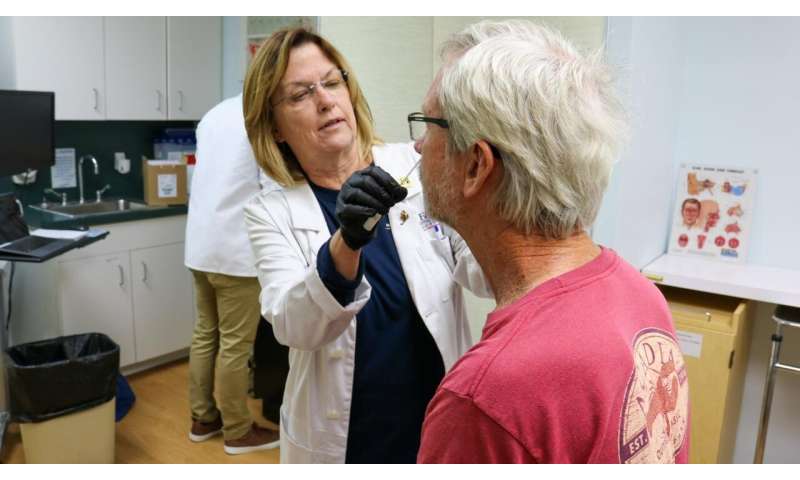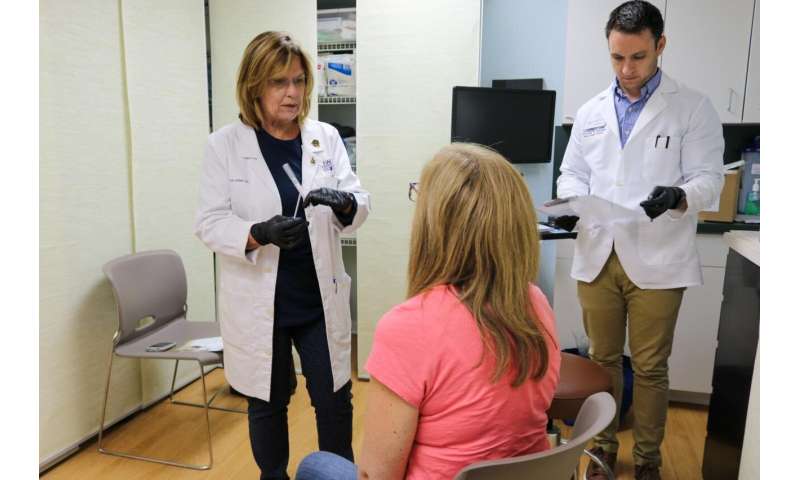The nose knows: Study establishes airborne exposure to harmful algal blooms’ toxins


Florida has experienced numerous harmful algal blooms in recent years, including blue-green algae and their toxins in 2016 and 2018. Despite their intensity and frequency, there is scant data on human exposure to these blooms and concentrations of the toxins they produce in tissues of exposed individuals. The most common routes of human exposure to these toxins include direct contact, ingestion and inhalation. Little is known about airborne exposure to these toxins in recreationally and occupationally exposed humans.
A study led by researchers at Florida Atlantic University’s Harbor Branch Oceanographic Institute in collaboration with FAU’s Christine E. Lynn College of Nursing and Colorado State University, was recently published in the journal Harmful Algae. The results provide evidence of aerosol exposure to microcystins among coastal residents.
Researchers detected microcystin, the main class of cyanotoxins produced by blue-green algae species, in the nasal passages of 95 percent of the participants. Some of these individuals reported no direct contact with impacted water. Therefore, these findings may be due to the aerosolization of cyanobacteria and transport in the air as has previously been hypothesized.
“Aerosolized cyanotoxins represent an important potential route of exposure and should be included in risk assessments for human populations,” said Adam Schaefer, M.P.H., lead author and an epidemiologist at FAU’s Harbor Branch. “Our study represents an essential first step in assessing and mitigating the potentially harmful effects of cyanobacteria blooms. We have a lot of unanswered questions to address regarding absorption of toxins, the minimum safe distance for persons from blooms, and potential health effects of exposure.”
The recently proposed limit of microcystins to minimize human health risks associated with direct contact with water through recreation and swimming was set at eight parts per billion by the United States Environmental Protection Agency. However, there are currently no limits specific to airborne concentrations of microcystins or inhalation guidelines.
Researchers also found higher concentrations among occupationally exposed individuals. The significantly higher nasal concentration among individuals whose job regularly brought them into contact with impacted bodies of water is an important finding. To date, little has been done to assess occupational exposure to blue-green algal blooms.

There were no significant differences in the mean microcystin concentration by gender, race, or level of education achieved. Individuals who reported having direct contact with impacted water such as boating and fishing in the past 24 hours had a significantly higher mean nasal microcystin concentration than those with no direct contact during that timeframe.
“Ninety-five percent of the individuals screened had a nasal microcystin concentration above the detection limit of the assay,” said Schaefer. “Only individuals screened at the end of the bloom period showed negative results. A relationship between nasal and water microcystin concentrations also was demonstrated.”
Study participants were recruited at public locations near Stuart, which is located at the mouth of the St. Lucie estuary downstream from Lake Okeechobee, between July 30 and Sept. 30, 2018. After completing a questionnaire, sterile cotton swabs were used to collect a sample from the nasal mucosa, which were analyzed for microcystin concentration. Concurrently, researchers collected and analyzed a total of 47 surface water samples, collected bi-weekly during that same timeframe. Environmental concentrations of microcystin in water samples were analyzed by sampling location and sampling week to correspond with human sampling locations and dates.
“Recent funding from the Florida Department of Health will allow us to expand this research to evaluate the potential long-term health effects of exposure to blue-green and red tide algae at multiple sites in the state,” said Schaefer.
Study co-authors are James Sullivan, Ph.D., executive director of FAU’s Harbor Branch; Luke Yrastorza, Nicole Stockley, Robert Grady, and Malcolm McFarland, Ph.D., all with FAU’s Harbor Branch; Kathi Harvey, FAU’s Christine E. Lynn College of Nursing; and John S. Reif, D.V.M, Department of Environmental and Radiological Health Sciences, Colorado State University.
Source: Read Full Article